| Old-Timer | Switcher |
 |  |
Side-Tank Switcher:
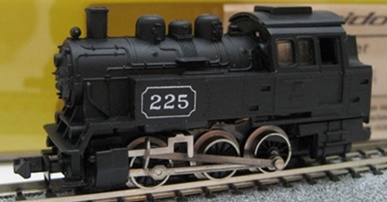
| Old-Timer | Switcher |
 |  |
Side-Tank Switcher:

Introduced: 1967
Arnold's 0-6-0 steamers come in three distinct flavors- the "Switcher", the "Old-Timer" and the "Side-Tank Switcher". Although, truth be told, the actual differences between the switcher and the old-timer are pretty minimal. The old timer has a wide smokestack and a cowcatcher pilot, whereas the switcher has a narrow smokestack and some sort of bent-hook pseudo-coupler on the pilot. The tenders are identical between the two, as are the shells. The side-tank switcher is based on a German prototype (designated BR 80 by the Deutsche Bundesbahn), so obviously nothing like it ever saw service in the US. All three models share the same basic chassis/mechanism. These early Arnold N scale models were originally imported and marketed in the USA by Revell (an arrangement that lasted just a few years). Walthers took over as the primary importer circa 1972, and the models were ultimately discontinued some time in the late-70's / early-80's.
The smokestacks function (rather ingeniously) as large screws, and when removed allow one to pull the locomotive shell off of the chassis -
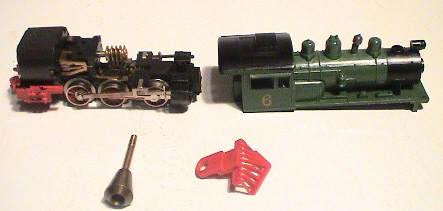
The original "Series 0" mechanism used by Arnold in their European 0-6-0 models of the early-to-mid 1960's employed a rather overly complicated array of worms, gears and driveshafts (making for just a whole lot of noise). Conversely, the "Series 1" mechanism used in these models is a bit less complex -
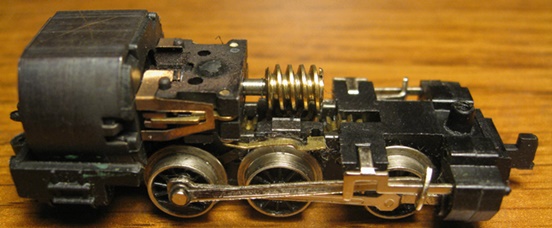
The portion of the motor that contains the winding is enclosed (but presumably three-poles / straight-wound). Oddly enough, the brushes and commutator are not enclosed (IE clearly visible). Kind of a strange arrangement, and one that I've never seen before (and who knows what purpose it might serve). Pickup is provided by wheelback wipers on the forward and rear driversets (the center driverset being electrically neutral). Metal extensions off of the wipers transfer current to the motor contacts. Only the forward and rear axles are geared (with all of the gearing being brass). There is no lighting and there are no traction tires. The wheel flanges are way oversized, so Code 55 rail is not an option
The side-tank switcher comes with Rapido couplers mounted inside pockets under the driver bottomplate. The switcher / old-timer tenders have a truck-mounted Rapido coupler on the back. The engine has a pivoting arm with a plastic cylinder that slots into a box on the forward tender truck. Unfortunately, the tender does not provide any sort of electrical pickup.
As one might expect, these somewhat primitive models are pretty much only good for running around in circles on a simple oval of track. Due to the extremely limited pickup scheme, throttle response from a dead stop or through turnouts can be a bit dodgy (although once they do get going, throttle response is quite smooth). Unfortunately, they're a bit noisy (probably due to all of those brass gears). Owing to the low-tech motor, these models tend to move too fast at low throttle settings, so slow-speed creep is not particularly impressive. And of course, the top-end speed is off the charts. Also, they tend to run very hot (for whatever reason). The side-tank switcher (with its metal shell) is particularly prone to heat retention (becoming quite hot to the touch after extended running). On the plus side, they're surprisingly strong pullers (20+ assorted freight cars on level track). So, basically trainset-style models that are probably going to be of limited appeal to "real" model railroaders.
Micro-Trains has had an 0-6-0 to 2-6-0 conversion kit for these models for many years. However, some time around 1980 Arnold released an actual 2-6-0 model of their own using the old-timer tender and locomotive shell (along with a slightly altered mechanism). And good luck finding one, they are pretty rare -

Interestingly enough, that same "slightly altered" mechanism was apparently also used on at least one 0-6-0 release. But beyond this one picture, I have never actually seen one myself, so they must be even more rare than the 2-6-0's -

Trivia - Back in the 1970s, a Detroit-area company called "Flint Models" produced brass shells for the Atlas/Riv C-Liner, 0-4-0, 0-8-0 and 4-6-2 models, along with Arnold's 0-6-0. The original concept was to improve traction/operation, what with the added weight allowing the engine to pull more and maintain better electrical contact. Rumor has it that these Flint shells were actually "lost plastic" castings, IE a plastic shell was destroyed for each brass mold produced. From what I've been told, the shells were actually made in Canada, and at some point the boys over at Flint actually got caught smuggling the brass across the border and went out of business rather suddenly.
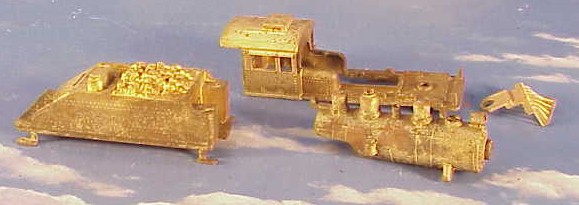
Collector Note- if you have the original Flint Models box that the shell came in, hang on to it like grim death. Apparently they are harder to find than the castings themselves. I'm told they were black plastic with a clear plastic hinged lid.
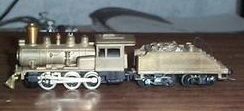
Grade: C
Reviewed: 4/67 Model Railroader ("This model appears to have no actual prototype but is an 0-6-0 steam switcher fairly representative of switchers used on American railroads. Some liberties had to be taken to fit the motor and other gear into an N scale body, but in general the model is well proportioned and as close to scale as one can expect. The engine and tender scale 60 feet long, 10 feet wide, and 15 feet high. The ready-to-run model is painted and lettered. The superstructures are well-made plastic castings with most detail cast on. The engine frame is part metal, part plastic. The scale 48" drivers (smaller than common U.S. practice but perhaps the flanges make optical reason for this) have plastic centers and nickel silver rims. A noticeable deviation is the overly wide firebox: necessary, however, to accommodate the motor. The mechanism is the same as used in the Rapido 0-6-0 tank engines (see 1/66 Trade Topics). The front and rear drivers are driven... The metal main and side rods connect to the rear drivers only. The side rods go into the cylinders, the main rods into the valve chests, making an oddball but reasonably effective looking mechanism. The center drivers are not connected; they run free. The engine wheels make all electrical pickups... Our test sample functioned smoothly, although electrical pickup at slow speeds tended to be erratic with the engine wobbling slightly from side to side... For its weight this little engine takes on a man-sized load of around 12 to 15 cars... The tender trucks are an AAR (Bettendorf) type with a scale 7-foot wheelbase. This is a new design that is not as well proportioned as the older Rapido AAR truck that had a six-foot wheelbase, which is closer to the prototype... Price: $17.98")